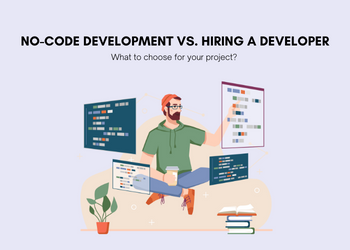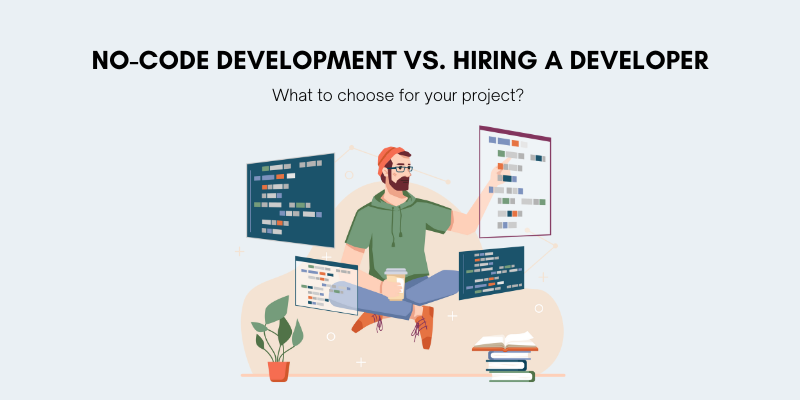No-Code Development vs. Hiring a Developer

With the rapid advancement of no-code in recent years, it has become a recognized approach for implementing various types of projects from start to finish. As a result, we typically distinguish three approaches: no-code, low-code, and code development.
Each method has a strong community surrounding it. We frequently hear that no-code is the future and that everyone should switch to it, that no-code is only appropriate for building simple prototypes, and that coding is the only solution. So, even though I represent a no-code startup, I’ve attempted to conduct an unbiased analysis and comparison of the most common methods to identify the pros and cons, as well as the most common use cases, for each option and see if one truly has to choose only one approach for a given project (spoiler: not really).
No-code Development
Code development and no-code appear opposed, as do their use cases and functionalities. Before we go any further, let’s first define no-code. No-code is a collection of tools that enable citizen developers to create projects without writing a single line of code.
There are numerous advantages to using no-code, including the following:
- No-code is a great way to try new things.
- It is appropriate for users with no technical background.
- No-code makes building and learning easier for beginners.
- No-code development is simple and enjoyable.
- Quick access to MVP (Minimum Viable Product).
- No-code helps to save time and money.
Thousands of people use no-code tools to create web applications, mobile apps, and websites. People prefer no-code tools because of their short learning curve and ease of use. Let’s look at some of the most popular no-code use cases to provide more context.
Internal resources
No-code can be used to create client portals, employee directories, admin panels, CRMs, and much more. Furthermore, users find that using no-code rather than code makes it easier and safer to automate their workflows.
Softr, Jet Admin, Retool, Internal, and Stacker are some of the best no-code tools for creating internal tools.
Marketplaces
No-code tools assist users in creating marketplaces such as Airbnb or Fiverr. Almost all no-code tools provide fantastic templates for service or product marketplaces, making the development process faster and easier. Shopify is probably the most popular solution for this use case. Still, Webflow, Bubble, Sharetribe, and other tools can also be used to build marketplaces successfully.
Side projects
A simple no-code side project could easily earn several thousand dollars per month. It could be anything: a community, resource, or product directory, for example. In theory, any no-code tool or set of tools could be used in this case. Still, because most people working on side projects have a limited budget and time, we’d recommend starting with platforms that don’t take too long to master and build a working product increment.
Now that you’ve learned about some of the use cases where no-code can be successfully applied let’s talk about the drawbacks of the no-code approach and when it’s not a good idea to use it.
Potential scalability issues
While we cannot say that building large enterprise applications with no-code is impossible, scalability is always a concern when working with no-code platforms. When developing a project that may require scaling shortly, you should consider potential performance issues (for example, a large number of users within a large enterprise system) as well as the ability of your tech stack to handle the system complexity. Other important factors that apply to large-scale projects will be discussed next.
Limited Customization
No-code solutions typically provide their users with pre-built pieces that can be quickly and easily assembled with a certain level of customization. The limitations on customizability are frequently intentional so that users who are not professional developers or designers do not get lost in various configuration options and become stuck. As a result, when selecting a tool for your project, you should always consider its customization limitations.
Security and stability concerns
It is critical to select a dependable solution for your project, especially if the nature and environment of your application necessitate a high level of stability and security. Unfortunately, even though no-code solution providers have begun to pay more attention to security and stability aspects in recent years as their areas of application have expanded, it’s no surprise that no-code platforms still can’t provide the level of reliability that can be achieved by custom-developed solutions that specifically address all potential risks associated with the given project and are thoroughly tested and adjusted before launch.
Low-code development
Another approach that has gained popularity in recent years is low-code. It extends the capabilities of no-code by allowing for the use of custom code. As a result, when compared to no-code development, low-code development provides greater flexibility and scalability while also requiring coding skills. Several low-code solutions are available today, and the following are some of the most common use cases for such a platform:
- Integrating an internal tool with a user-facing solution: A custom integration with code may be the only option if no ready solution exists.
- Increasing the functionality of coded applications. Easily add new features to your code by using pre-built components.
- Prototypes and betas in detail: While the core functionality can be coded, low-code platforms allow you to add new features and easily test and iterate quickly.
Let’s look at what code development has to offer compared to the methods discussed above.
Code development
Code development is traditional coding, the most widely known and used approach to development. Code development has no bounds because it allows you to create anything you can think of. It would be a lie to say that code development is flawless, but we will discuss its drawbacks later in the article.
Let’s examine why so many people prefer to code their projects.
- The only way to deal with the complexity of the development process is through code.
- More flexibility and a sense of ownership are associated with code.
- For more complex products, code is the most scalable solution.
- The most secure way to build digital products is through code.
As a result, the coded approach has several benefits, including:
- Possibilities abound: With code, you can create anything you want.
- Building in high-security environments, such as healthcare, banking, or insurance.
- High-level technologies: Creating with AI, blockchain, NLP, and other fourth-generation technologies.
Every good thing has a price. The development of code is no exception. It is suitable for any project idea you have in mind, but you should consider the following code development disadvantages.
Code development is expensive
One of the most significant disadvantages is the cost of constructing code-compliant projects. You will be responsible for all expenses incurred during the development process. The cost of developing a code-based project will vary depending on your needs. Even the bare minimum is far greater than the monthly subscription to the no-code tools.
Finding good developers can be difficult.
Sure, many skilled developers are available, but finding a qualified specialist is difficult, especially when time and money are limited. Some developers charge exorbitant fees for their services, and their schedules are set months in advance. You’ll have to wait a while for such a specialist to join your team, which could take anywhere from a few days to a few months, which doesn’t seem like a good idea. As a solution, consider the staff augmentation model and contact Bestarion to scale your development team with top-tier contract engineers quickly.
Inclusion
Nowadays, we frequently hear that no-code is the future and that coding will eventually become obsolete. However, this is not the case. Code is becoming increasingly important, and low- and no-code solutions supplement it. Furthermore, someone will have to code the no-code tools that non-developers will use. As we attempted to demonstrate, there is no correct approach. The method and set of tools you choose are determined by the nature of the project and the environment in which your final product will operate.
No-code solutions may be better suited for entrepreneurs and independent creators looking to quickly validate their ideas, build a side hustle project, create a simple marketplace, and so on (though this is gradually changing as no-code solutions become more powerful). On the other hand, custom-coded applications are the go-to solution for larger and more complex applications (e.g., enterprise solutions for HealthTech, FinTech, and other industries), where security and stability are critical.
Furthermore, in some cases, a hybrid approach (a combination of no-code, low-code, and code solutions) may be more appropriate than selecting a specific solution. As a result, people and organizations should be concerned with the outcome rather than the limitations. It is critical first to determine the desired outcome and then determine which approach or combination of approaches and platforms is best suited for achieving that outcome.

